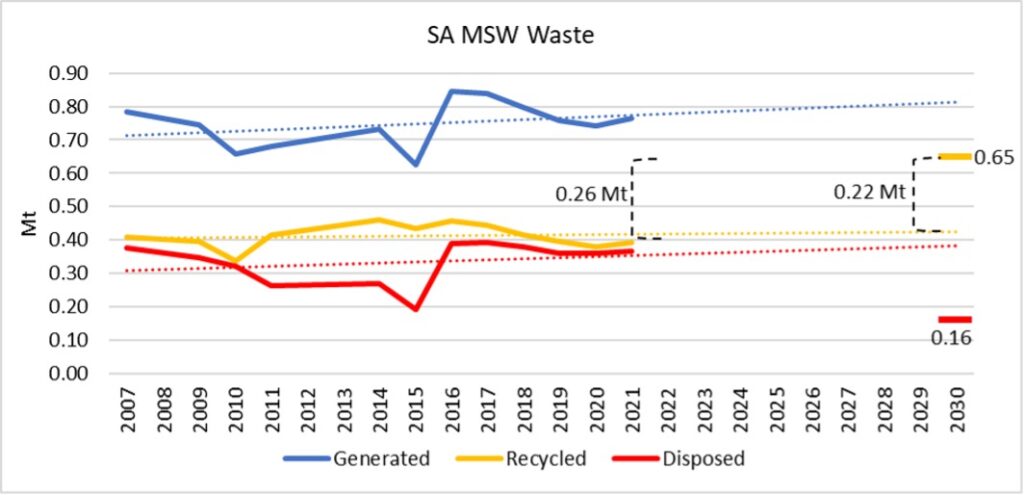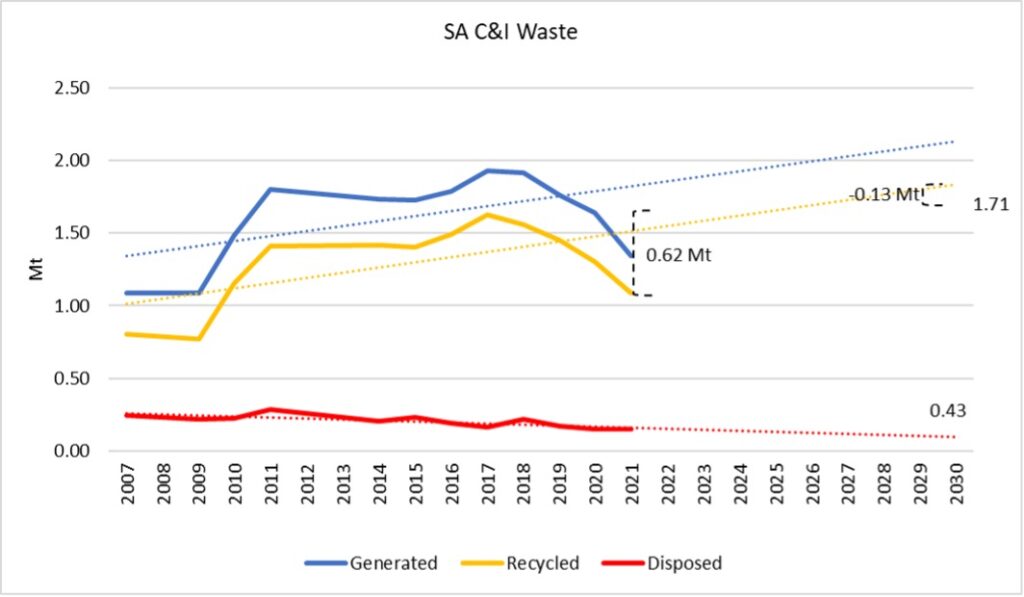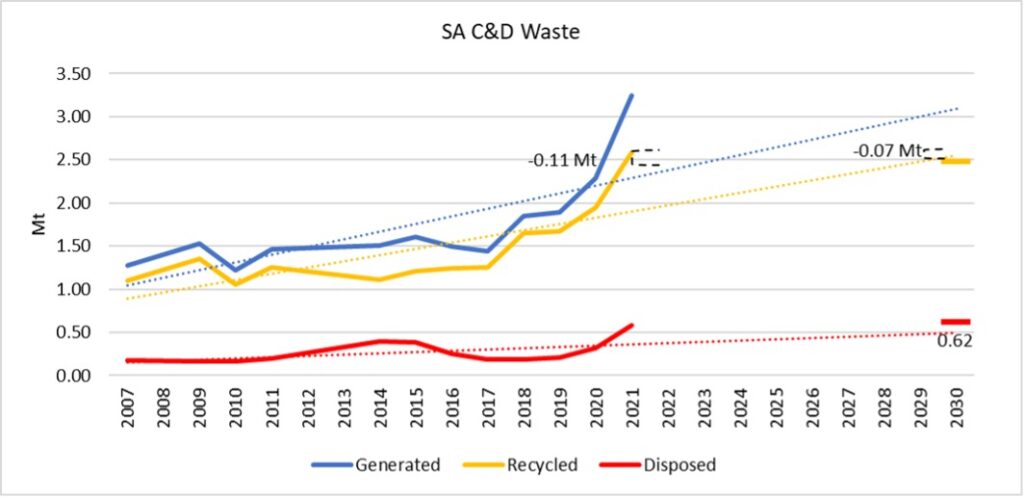SA- The leader of the recycling pack

By Mike Ritchie, Director, MRA Consulting Group
South Australia leads recycling rates in Australia.
Table 1 shows a comparison of States based on the latest National Waste Action Plan report.
It shows that SA is head and shoulders above the rest with the next best VIC and NSW at 66% and 61% respectively.
A 76% statewide recycling rate is truly impressive.
| State | Recycling Rate % |
|---|---|
| SA | 76% |
| Vic | 66% |
| NSW | 61% |
| WA | 59% |
| Qld | 53% |
| ACT | 50% |
| Tas | 44% |
| NT | 18% |
| Average | 62% |
With a National Waste Policy Target of 80% resource recovery by 2030, it would appear that SA is the only State on track to achieve it.
If we look at the trend line since 2007 (Figure 1) it shows that while waste generation continues to grow in SA, recycling (yellow line) is neatly keeping up with it.
All other things staying the same and with continued growth in recycling Figure 1 shows that SA should meet the recycling rate of 4.8 MT/yr in 2030.
Further (again pareto rule) waste to landfill is also set to come in on target at less than 20% by 2030.

We can do the same analysis per major waste stream.
Household waste
Household waste is not quite as rosy (Figure 2). In fact, the recent National Waste data shows that household recycling rates have actually fallen since 2016, while landfill rates jumped up (and then returned to trend). (I suspect there is a data problem behind some of the wild shifts).
All other things remaining equal the recycling rates of the household sector will be about 200,000t short of the target in 2030.
Domestic recycling needs to grow from 0.4MT to 0.65MT/yr or by 50% to be on track for the 2030 recycling goals.
While the percentage improvement sounds like a lot, it is not many tonnes as you might think. The gap can be closed in the next 6 years.
The key areas to find that 200kt include:
- Improved organics (FOGO) diversion
- Increased separation of householder delivered waste to landfill sites (e.g. driven by higher levies)
- Expansion of the CDS scheme to include wine and a higher rebate (e.g. 20c)
- Energy from Waste.

Commercial (C&I)
Figure 3 shows that Commercial Waste generation and recovery have been falling in SA since 2017.
I suspect that is a data quality issue and the early effect of Covid 19 which was identified in Australia in January 2020.
The fall in waste generation of 500kt since 2016 has most likely got data issues.
On these trends however the commercial sector is on track to achieve an 80% resource recovery rate by 2030.
The major reform initiatives that will underpin continuing resource recovery will no doubt include:
- Improved organics (commercial food) diversion
- Increased on-site separation (e.g. driven by higher levies)
- Expansion of the CDS scheme to include wine and a higher rebate (e.g. 20c)
- Energy from Waste.
A very similar list to the household sector.

Construction Waste
The Construction and Demolition sector (C&D) is the standout success story in SA.
A combination of early movement on the landfill levies plus generous rates of hypothecation of the levy funds back to infrastructure and processing of waste, has driven higher recovery rates.

It is pretty obvious that generation rates and recycling rates in SA took off in 2017.
There was either an incredible development boom or this is again a data issue. The case for the former is good as SA saw a 23% increase in their construction industry employment from 2016 to 2021[1].
I suspect it was a data issue and the jump was the result of a new EPA requirement for mandatory reporting of licenced sites (both landfills and recycling facilities).
Nonetheless, the C&D sector is on track to beat the resource recovery target.
The key reforms that will further drive the C&D recycling rate will likely include:
- Real increases in landfill levies.
- Grants for infrastructure from levy funds.
The SA Government has shown a willingness to hypothecate landfill levies to resource recovery projects and that is particularly reflected in the C&D sector. Well done SA Government.
So what is it that SA is doing to set it apart?
The policy settings
- SA was an early adopter of landfill levies and pricing to improve recycling
- SA has the highest hypothecation rate of landfill funds to new services and recycling infrastructure
- SA has a dedicated department who’s job it is to grow recycling (which is separate from the EPA regulator)
- SA was a very early adopter of Container Deposits (while the tonnes are small, CDS is a powerful mechanism to engage voters in waste reform).
- SA government and its agencies ask questions about what they can do to improve recycling via policy, regulation, markets and facilitation.
[1] South Australia | Industry sector of employment | Australia | Community profile .idcommunity Demographic Resources. Available at: https://profile.id.com.au/australia/industries?WebID=130 (Accessed: 07 March 2024).
Summary:
- SA is the only State that is on track to achieve the Targets overall and is likely to achieve that in the C&I and C&D sectors so long as reform continues.
- The Household sector needs further accelerated reform (and possibly better data) to achieve its recovery target.
- Other States could learn from the SA approach.
Mike Ritchie is the Managing Director at MRA Consulting Group.
This article has been published by the following media outlets:




